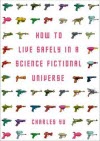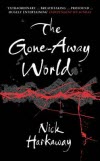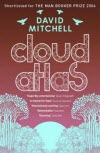Living Between Worlds
David Barnett looks at a book by Charles Yu that has been attracted attention for both its literary and science fictional qualities.
When it happens, this is what happens: I open a book that I think is going to be one of these cod-guide books offering advice on improbable scenarios such as surviving the zombie apocalypse or coping with first contact with extra-terrestrials, and what happens is that I fall headlong into a paradox.
Several paradoxes, actually. The first one is not so much a paradox as perhaps a lie: That there is a strict demarcation between supposed “literary fiction” and “genre fiction”. The lie is that these distinct literary forms inhabit, Venn-diagram-like, two worlds. To use the language of lit-fic, that world often appropriates and utilises the devices and tropes of science fiction and fantasy, often to critical acclaim. In genre terms, it vampirises SF/F, dresses the essence up in clothes fit for polite society, and continues to get shelved under “fiction” and receive full-page reviews in the newspapers.

The lie is not just that lit-fic and genre are distinct and separate forms, but that genre is somehow lacking in the qualities that put the literary in lit-fic: good writing, intelligent composition, and realistic characters. When genre titles do receive recognition for these qualities, they sometimes find themselves in an almost non-existent but ontologically valid crossover between the two worlds. It is a sparsely populated region, but here you will find Charles Yu’s rather astonishing debut novel, How To Live Safely In A Science Fictional Universe. [Purchase].
Hmm. On first glance, you might notice a couple of things about Charles Yu’s novel. Well, the very first thing you’ll notice is the Day-glo front cover which is comprised of precisely 50 golden age rayguns and one dog. Upon reading you’ll notice writing of the style crudely aped in the top three paragraphs of this piece; almost breathlessly conversational prose, polished so much that you can see your reflection in it, but a little warped, like the back of a spoon. You’ll also find what at very first look appears to be lots and lots of jargon-heavy info-dump of the type of science that, unless you know your stuff, could be genuine or could be utter codswallop.

So we have this little negative zone between these two fictional spheres in which How To Live In A Science Fictional Universe sits; this paradox that the act of opening the covers plunges you into. Charles Yu isn’t alone in this contrived Venn zone, and to know his neighbours you only have to look at the cover shouts provided by fellow authors. There are big-ups to Yu from Nick Harkaway, the author of The Gone-Away World [Purchase], Audrey Niffenegger, The Time-Traveller’s Wife [Purchase], and Colson Whitehead — The Intuitionist [Purchase] and Apex Hides The Hurt [Purchase], among others.
Harkaway, Niffenegger and Whitehead all inhabit this nebulous territory between literary and genre fiction. Their books are, by anyone’s standards, speculative, fantastical, outre and surreal. But their publishers have taken great pains to market them to a wider audience as well as through the usual genre channels. And why not — their writing cries out for as large a readership as possible. To their number, we can now add Charles Yu.
Perhaps.
Because while Yu’s scintillating prose and Eggers-style You-Shall-Know-Our-Velocity kind of obtuse title mark him out as drenched in literary aspirations, there’s the small matter of those 50 Day-glo rayguns. And the fact that Yu’s novel is about time travel. And not the organic, heart-aching, unexplained time travel of Niffenegger; this is as hard-as-it-gets time travel, with time machines and science talk and computers and everything. In fact, it’s your classic time travel story, that could have been ripped straight out of a hundred 1950s pulp magazines. What would happen if I met myself from another time… and killed me?
And this is the paradox that Yu’s novel tipped me into within a dozen pages. Not just that it sort of sounds like a literary novel but looks like an SF novel but reads like a literary novel but actually, no, it reads like a super-hard SF novel… The paradox for me was that, as someone who’s never really got on with SF novels stuffed with science, I absolutely fell in love with this straight away. And by its very existence, Yu’s novel shoots that old argument about lit-fic vs genre right down in flames.
Take the book’s opening gambit, shamelessly ripped off by myself in homage right at the top of this piece: “When it happens, this is what happens: I shoot myself. Not, you know, my self self. I shoot my future self. He steps out of a time machine, introduces himself as Charles Yu. What else am I supposed to do? I kill him. I kill my own future.”
And that’s the sort of grabby little hook of which great openings are made. Anyone who’s seen Doctor Who can grasp this; your grandma can get her head around this. This is going to be a novel of big ideas but simply told, right?
Yeah. Try this on for size, from much later on in the book: “In Minor Universe 31, quantum decoherence occurs when a chronodiegetic system interacts with its environment in a thermodynamically irreversible way, preventing different elements in the quantum superposition of the system + environment’s wave function from interfering with one another.”
At which I, let alone your grandma, would in normal circumstances simply throw in the towel. See that mainstream audience you’ve been gunning for, Mr Yu? They’re heading for the hills.
Or are they? Well, I didn’t. Because by this point, I loved Yu’s book so much that this science — and I still have no idea what the hell he’s talking about — didn’t matter.
The novel is about a time machine repairman whose name happens to be Charles Yu — another lit-fic conceit, and one I employed myself when I used to have literary aspirations. The fictional Charles Yu has spent the best part of ten years bumming about in the aforementioned Minor Universe 31, which is kind of a pocket universe. It is around 17 per cent reality, and the rest is filched from classic SF book and movie tropes — hence the clever-clever title of the novel, which we now find out does actually mean something.
Charles has his own time machine, a TM-31 Recreational Time Travel Device, which is kind of a reverse-TARDIS — its connected to the hyper-reality of time and all these crazy little leisure universes, but is pretty much as big as a cupboard inside. Charles shares his cramped quarters with TAMMY, the time machine’s user-interface, with which he’s a little bit in love, and Ed, a dog who doesn’t actually exist but is, we are told, “ontologically valid”. His major contact outside the time-streams is Phil, his nominal boss back at wherever time machine central is. Only thing is, Phil is a software programme — Microsoft Middle Manager 3.0 to be exact — and Charles isn’t exactly as nice as he could be to him.
His job as a time machine repairman is to jump around rescuing all those people who use recreational time travel to go back in their own time-streams and try to change stuff, creating the paradoxical problems that are the meat and potatoes of such fiction. The novel is interspersed with the science bits from Charles’s work manual — also handily called How To Live Safely In A Science Fictional Universe.
The crisis point of the novel comes when Charles Yu sees his future self stepping out of a time machine. And because any idiot knows that meeting yourself can make the universe go pop or create divergent time-lines and all that stuff, he does the only thing he can do: shoot his future self. But therein lies Charles’s problem and the crux of the novel — because, at some point in his future, he climbs out of a time machine and confronts his past self, and gets shot. Charles’s destiny is paved in concrete. There’s nothing he can do after shooting his future self but climb into his time machine and travel to the moment when he gets shot, because it’s already happened. So that’s what he does.
And in that wonderfully stretched moment the bulk of this superb novel is laid out for us. Because this isn’t a 50s era science fiction adventure, really. It’s the story of Charles Yu’s search for his father, who stepped into a time machine one day and disappeared, and never came home. Charles’s mother copes with this by electing to trap herself in a never-ending Moebius strip of time where she’s always in the kitchen rustling up the perfect dinner, and Charles is the attentive son doting on her every word.
This is a book that is nominally about time travel, but what it’s really about is not moving in time. Charles’s mother relives her endless perfect day, his father is lost in the past, and Charles himself is locked in a time loop where he shoots himself then jumps forward in time to get shot. It’s about why people end up trapped in a moment, unable to move forward.
Charles’s reminiscences about his early life with his father are tender, awkward and ultimately heart-breaking. It’s this relationship that is at the beating heart of this shiny little novel. If the time travel makes this book science fiction, then the father-son dynamic makes this book literary. But, after reading it, all such comparisons and contrived oppositions of lit-fic and SF are odious and unnecessary. How To Live Safely In A Science Fictional Universe is just a beautifully written novel about time travel and families.

It would be interesting to see what would have happened if this book had been picked up by a mainstream TV book club, such as Oprah in the States or Richard and Judy in the UK. It could have springboarded Yu to general appeal — after all, in Britain, the aforementioned Richard and Judy championed David Mitchell’s Cloud Atlas [Purchase] to a daytime TV audience, and they seemed to have little difficulty with the far future chapters nesting at the centre of that book.
I don’t really mind Yu’s UK publishers, Corvus, trying to market this as general fiction, but by the same token the only reviews I’ve really seen of it have been in the genre presses or, in the case of the mainstream media, written by SF authors (The Guardian seems rather confused about who reviewed the book).
Yu’s writing style is neat and chatty and, if there’s a section where it all gets a bit self-indulgently trippy- stream-of-consciousness-2001: A Space Odyssey, we can forgive him that for the tight, detailed strokes with which he draws his characters.
A few chapters into How To Live Safely In A Science Fictional Universe I felt excited in a way that reminded me how I reacted to the final chapters of Grant Morrison’s Invisibles comic — I wasn’t exactly sure that I understood everything that was going on, but that sort of gave me a thrill as well. All I knew for sure was that I loved it.
Flicking through the book again prior to writing this, I was surprised at how much of the original narrative I’d forgotten about. Like a piece of perplexing contemporary art, the shape and impression of How To Live Safely In A Science Fictional Universe stays with you long after reading, even if some of the finer brush-strokes don’t. I very much look forward to Charles Yu’s next efforts.
If you enjoyed this article, please consider supporting Salon Futura financially, either by buying from the Wizard's Tower Bookstore, or by donating money directly via PayPal.
Pingback: Welcome to the website of David Barnett | Postcards from the Hinterland